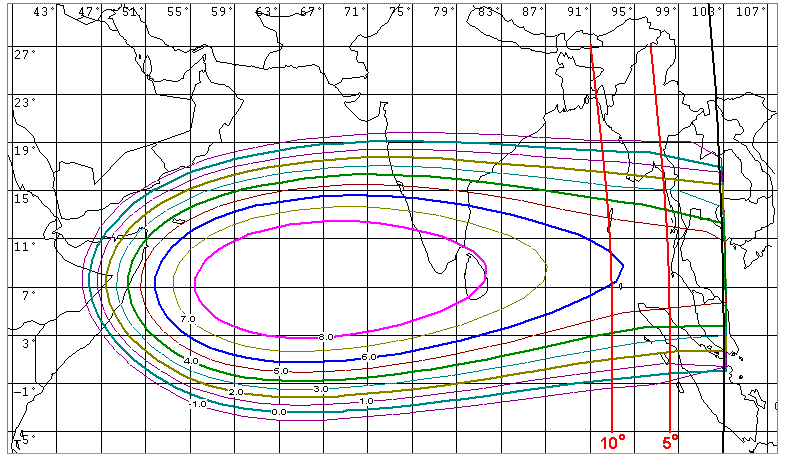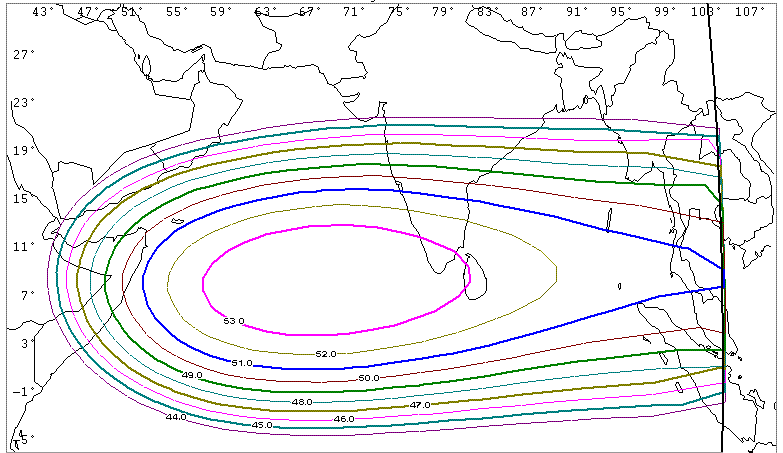|
European VSAT satellite service providers |
Asian earthquake: Emergency satellite communications beam for the Indian Ocean region.
The coverage map below illustrates an example as used in 31 Dec 2004. The Eutelsat satellite was located at 21.5 deg east.
Coverage map for tsunami emergency satellite communications beam coverage in the Indian Ocean area.

The satellite uplink G/T contour lines on the above map are -1, 0, 1, 2, 3, 4, 5, 6, 7, 8 dBK and are relevant to the uplink C/N calculation (link budget). At the outer edge of the beam you need more uplink power into the air (EIRP) to get a good signal into the satellite, so you need a combination of larger dish diameter or a more powerful transmit Block Up Converter (BUC) or combination of the two in order to transmit a suitable transmit eirp power towards the satellite.
If you are dealing with isolated islands not marked on the map determine the latitude and longitude by other means and then mark the location on the above coverage patterns.
For pointing angles go to satellite dish pointing angle calculator
Azimuth pointing angle: The dish pointing azimuth angle is generally to the west, approx where the sun sets.
Elevation pointing angle: I have inserted the 10 deg and 5 deg elevation contours - see above in red. I do not recommend Ku band operation below 10 deg elevation in normal circumstances. Below 10 deg elevation signal level variations (up and down) will occur due to tropospheric scintillation, like the twinkling of a star near the horizon. This will make dish peaking up / aiming difficult. Try however to maximise link margin as fading and enhancements of several dB will occur. Towards the zero end of the 0 to 5 deg elevation range level increases of up to +5 dB may occur, interspersed with -15 dB fades every few 10s of seconds. This situation may apply for hours at a time in warm calm humid conditions.

The satellite downlink power EIRP contour lines on the above map are 44, 45, 46, 47, 48, 49, 50, 51, 52, 53 dBW and are relevant to the downlink C/N calculation (link budget). At the outer edge of the beam you need larger dish diameter to successfully receive the signal. In the central beam area a very small dish will suffice as the signals is exceptionally strong. Be careful, this excellent signal will make finding the satellite easy but may make accurate peaking up difficult as you will get 'perfect' reception over a rather wide beam peak. You must still make a real effort get the dish pointing to the exact centre of the broad beam peak to assure successful transmit operation (and link margin).
Dish sizes and BUC power required: dish diameter presently estimated as 1.2m at outer edge of beam, smaller towards the centre.
RX LinkStar box set up parameters for the DSTAR outbound carrier on Eutelsat W6 satellite (21.6E) over Indian Ocean.
F = 11554.41 MHz, pol = X, SR = 27.5 Mbaud, FEC = 2/3
We are working to bring the carrier up on Thursday 30 Dec. I will inform you as soon as it will be on the air. Now reported operational 31 Dec 2004. Well done.
Advice on safe drinking water treatment / diarrhoea / dehydration below:
Dear Sir/Madam.
Two years ago, as a medical professional I was victim of a great disaster. I coordinated evacuation of 40.000 people.
From my training and from experience I fear the days to come. INFECTIOUS DISEASES CAN MAKE THE DEATH TOLL TENFOLD.
Could you please inform us about the possibility to meet the urgent need for free information about the use of safe drinking water and prevention diagnosis and treatment of diarrhoea and dehydration, in disaster area.
Our messages are simple and will not contain more than 160 characters. They are called MUSTS: Medical Updates SMS Tsunami = MUST
Our messages are:
Message 1: " Prevent diarrhoea/dehydration: drink CLEAN fluid and be hygienic "
Message 2: " 1 litre Unsafe water add 4-7 drops common antiseptic, chlorine or iodine solution, wait 30 minutes = OK "
Message 3: " Heat: Bringing water to a boil makes it OK. No need to boil more than 1 minute "
Heat: Sufficient heat will kill micro-organisms in contaminated water already at a temperature below boiling point. The time to heat the water to a boil makes it hot long enough to disinfect it. There is no need to boil water for 5 minutes, 10 minutes, or 20 minutes, as some guide books recommend! Bringing water to a boil is adequate for dis-infection.
Walter Schrader (MD): Former head of department Social medical Care and disaster relief manager of Rotterdam Area
|
► Page created 31 Dec 2004, amended 13 March 2024. All pages on this satsig.net web site are Copyright Satellite Signals Limited © 2005 all rights reserved. |